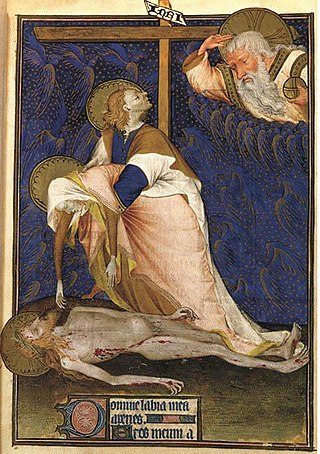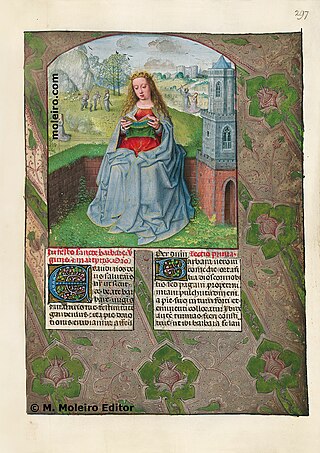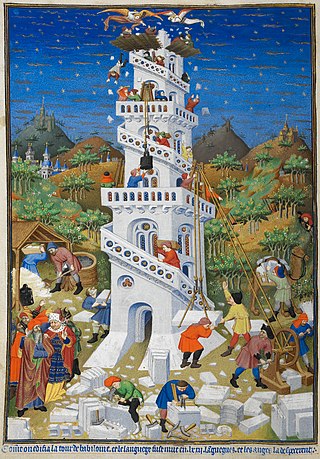
The Book of Kells is an illuminated manuscript and Celtic Gospel book in Latin, containing the four Gospels of the New Testament together with various prefatory texts and tables. It was created in a Columban monastery in either Ireland or Scotland, and may have had contributions from various Columban institutions from each of these areas. It is believed to have been created c. 800 AD. The text of the Gospels is largely drawn from the Vulgate, although it also includes several passages drawn from the earlier versions of the Bible known as the Vetus Latina. It is regarded as a masterwork of Western calligraphy and the pinnacle of Insular illumination. The manuscript takes its name from the Abbey of Kells, County Meath, which was its home for centuries.

Books of hours are Christian prayer books, which were used to pray the canonical hours. The use of a book of hours was especially popular in the Middle Ages, and as a result, they are the most common type of surviving medieval illuminated manuscript. Like every manuscript, each manuscript book of hours is unique in one way or another, but most contain a similar collection of texts, prayers and psalms, often with appropriate decorations, for Christian devotion. Illumination or decoration is minimal in many examples, often restricted to decorated capital letters at the start of psalms and other prayers, but books made for wealthy patrons may be extremely lavish, with full-page miniatures. These illustrations would combine picturesque scenes of country life with sacred images.

The Très Riches Heures du Duc de Berry, or Très Riches Heures, is an illuminated manuscript that was created between c. 1412 and 1416. It is considered a book of hours, which is a type of Christian devotional book or a collection of prayers that was said at canonical hours. The manuscript was created for John, Duke of Berry, the brother of King Charles V of France, by Limbourg brothers Paul, Johan and Herman. The book is now MS 65 in the Musée Condé, Chantilly, France.

The Rabbula Gospels, or Rabula Gospels, is a 6th-century illuminated Syriac Gospel Book. One of the finest Byzantine works produced in West Asia, and one of the earliest Christian manuscripts with large miniatures, it is distinguished by the miniaturist's predilection for bright colours, movement, drama, and expressionism. Created during a period from which little art survived, it nevertheless saw great development in Christian iconography. The manuscript has a significant place in art history, and is very often referred to.

The Syriac Bible of Paris is an illuminated Bible written in Syriac. It dates to 6th or 7th century. It is believed to have been made in northern Mesopotamia. The manuscript has 246 extant folios. Large sections of text and the accompanying illustrations are missing. The folios are 312 by 230 mm. For reasons of economy, the text is written in three columns.

The Paris Psalter is a Byzantine illuminated manuscript, 38 x 26.5 cm in size, containing 449 folios and 14 full-page miniatures. The Paris Psalter is considered a key monument of the so-called Macedonian Renaissance, a 10th-century renewal of interest in classical art closely identified with the emperor Constantine VII Porphyrogenitus (909-959) and his immediate successors.

William de Brailes was an English Early Gothic manuscript illuminator, presumably born in Brailes, Warwickshire. He signed two manuscripts, and apparently worked in Oxford, where he is documented from 1238 to 1252, owning property in Catte Street near the University Church of St Mary the Virgin, roughly on the site now occupied by the chapel of All Souls College, where various members of the book trade lived. He was married, to Celena, but evidently also held minor orders, as at least three self-portraits show him with a clerical tonsure. This was not unusual: by this date, and with the exception of the St Albans monk Matthew Paris, the only other English illuminator of the period about whom we have significant personal information, most English illumination seems to have been done in commercial workshops run by laymen.

The Grandes Heures de Rohan is an illuminated manuscript book of hours, painted by the anonymous artist known as the Rohan Master, probably between 1418 and 1425, in the Gothic style. It contains the usual offices, prayers and litanies in Latin, along with supplemental texts, decorated with 11 full page, 54 half page, and 227 small miniatures, decorated with tempera paints and gold leaf. The book margins are decorated with Old Testament miniatures with captions in Old French, in the style of a Bible moralisée. The full page illuminations are renowned for the highly emotional and dramatic portrayal of the agonies of Christ and the grief of the Virgin. According to Millard Meiss, "The Rohan Master cared less about what people do than what they feel. Whereas his great predecessors excelled in the description of the novel aspects of the natural world, he explored the realm of human feeling." Meiss concludes that the Rohan Master was the "greatest expressionist in 15th century France." The manuscript is currently housed in the Bibliothèque Nationale, Paris, France.

The Belles Heures of Jean de France, Duc de Berry, or Belles Heures of Jean de Berry is an early 15th-century illuminated manuscript book of hours commissioned by the French prince John, Duke of Berry, around 1409, and made for his use in private prayer and especially devotions to the Virgin Mary. The miniatures of the Belles Heures are mostly painted by the Limbourg brothers; very few books of hours are as richly decorated as it.

The Isabella Breviary is a late 15th-century illuminated manuscript now in the British Library, London. Queen Isabella I of Castile was given the manuscript shortly before 1497 by her ambassador Francisco de Rojas to commemorate the double marriage of her children and the children of Emperor Maximilian of Austria and Duchess Mary of Burgundy.

The Howard Psalter and Hours is a 14th-century illuminated prayerbook. It includes a liturgical Psalter with canticles and litany, the Office of the Dead, a calendar of East Anglian origin and an incomplete Hours of the Passion. It was produced between 1310 and 1320. It is written in Latin in a Gothic script in two columns per page. There are 115 extant folios which measure 360 by 235 mm. The text block occupies an area of 250 by 166 mm. It is bound together with the De Lisle Psalter, a contemporary psalter.

The Hours of Étienne Chevalier is an illuminated book of hours commissioned by Étienne Chevalier, treasurer to king Charles VII of France, from the miniature painter and illuminator Jean Fouquet.

The Black Hours, MS M.493 is an illuminated book of hours completed in Bruges between 1460 and 1475. It consists of 121 pages (leaves) with Latin text written in Gothic minuscule script. The words are arranged in rows of fourteen lines and follow the Roman version of the texts. The lettering is inscribed in silver and gold and placed within borders ornamented with flowers, foliage and grotesques, on pages dyed a deep blueish black; hence its designation as a Black books of hours. The book contains fourteen full-page miniatures and opens with the months of the liturgical calendar, followed by the Hours of the Virgin, and ends with the Office of the Dead.

The Hours of Mary of Burgundy is a book of hours, a form of devotional book for lay-people, completed in Flanders around 1477, and now in the National Library of Austria. It was probably commissioned for Mary, the ruler of the Burgundian Netherlands and then the wealthiest woman in Europe. No records survive as to its commission. The book contains 187 folios, each measuring 225 by 150 millimetres. It consists of the Roman Liturgy of the Hours, 24 calendar roundels, 20 full-page miniatures and 16 quarter-page format illustrations. Its production began c. 1470, and includes miniatures by several artists, of which the foremost was the unidentified but influential illuminator known as the Master of Mary of Burgundy, who provides the book with its most meticulously detailed illustrations and borders. Other miniatures, considered of an older tradition, were contributed by Simon Marmion, Willem Vrelant and Lieven van Lathem. The majority of the calligraphy is attributed to Nicolas Spierinc, with whom the Master collaborated on other works and who may also have provided a number of illustrations.

The Westminster Psalter, British Library, MS Royal 2 A XXII, is an English illuminated psalter of about 1200, with some extra sheets with tinted drawings added around 1250. It is the oldest surviving psalter used at Westminster Abbey, and is presumed to have left Westminster after the Dissolution of the Monasteries. It joined the Old Royal Library as part of the collection of John Theyer, bought by Charles II of England in 1678. Both campaigns of decoration, both the illuminations of the original and the interpolated full-page drawings, are important examples of English manuscript painting from their respective periods.

The Sforza Hours, is a richly illuminated book of hours initiated by Bona Sforza, widow of Galeazzo Sforza, Duke of Milan, around 1490, who commissioned the illuminator Giovanni Pietro Birago. The book remained in an unfinished state for 30 years until Margaret of Austria, Regent of the Netherlands, commissioned its completion in 1517–20 from the artist Gerard Horenbout. The book therefore contains decoration of the highest quality by two artists. It provides a unique example of an early sixteenth-century Northern Renaissance illuminator's response to Milanese art of the late Quattrocento. The history of the Sforza Hours also includes one of the earliest recorded examples of art theft.

The Bedford Hours is a French late medieval book of hours. It dates to the early fifteenth century (c. 1410–30); some of its miniatures, including the portraits of the Duke and Duchess of Bedford, have been attributed to the Bedford Master and his workshop in Paris. The Duke and Duchess of Bedford gave the book to their nephew Henry VI in 1430. It is in the British Library, catalogued as Add MS 18850.

The Hours of Joanna I of Castile is a sixteenth-century illuminated codex housed in the British Library, London, under call number Add MS 35313.

The Book of Hours of Simon de Varie is a French illuminated manuscript book of hours commissioned by the court official Simon de Varie, with miniatures attributed to at least four artists; hand A who may have been a workshop member of the Bedford Master, the anonymous illustrators known as the Master of Jean Rolin II, the Dunois Master and the French miniaturist Jean Fouquet. It was completed in 1455 and consists of 49 large miniatures and dozens of decorative vignettes and painted initials, which total over 80 decorations. Fouquet is known to have contributed six full leaf illuminations, including a masterwork Donor and Virgin diptych. A number of saints appear - Saint Simon is placed as usual alongside Saint Jude ; other pages feature saints Bernard of Menthon, James the Greater and Guillaume de Bourges.

The Cloisters Apocalypse, MS 68.174 is a small French illuminated manuscript dated c. 1330. It is based on John the Evangelist's New Testament visions and apocalyptic revelation. According to Christian legend John was exiled c. 95 CE to the Aegean island of Patmos, where he wrote the Book of Revelation. The book evokes John's despair and isolation while exiled, and his prophecy of events and terrors of the last days.























